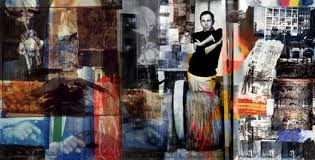 |
| FINAL "Stir Fry" 16 x 20 Oil on Canvas -- framed. |
I am a risk taker. I like to experiment. Sometimes I get lucky, and sometimes
I’m disappointed. I stretch my skills and challenge myself to try different
techniques and colors that enliven my palette. There is a certain light or glow
I seek that emanates from my paintings. Until I have achieved that look and
feel, I am not satisfied.
Using tools to build-up texture that ends up showing through may give
you an unusual under painting over which you can layer, wipe off, or touch up
with soft color, highlights or added lines.
 |
| (Underpainting; notice plastic rake tracks, swirls of color, mounds, etc.) |
An artist from Australia, Robert Bosler, suggests that “how you apply paint (your technique)
becomes a tool. There are refining techniques and empowering techniques.” Samples
of both are at a link below for YouTube.
Tools of the trade for an artist can be digital or as simple as a
plastic rake or a handful of tissue paper.
I enlarge my drawings or photos on
my PC to the size of my canvas. This allows me to block in the large items and saves
me from always having to draw or transpose detail. Using my paint brush as a
drawing tool, I can easily change or add to my composition. The details can be added later.
 |
| (This is the final result over that last underpainting--flipped to portrait position.) |
A novice once asked me for information on what it cost me
to do a painting. He divided it into parts: supplies, paints, canvas, tools and
time spent in the actual painting?
This picayunish breakdown was designed to
belittle me and other artist’s work with little regard to the years it takes to
perfect a skill or the knowledge required to assimilate what one sees and to interpret
it on canvas.
I gave him a simple mathematical tool to determine costs:
Multiply the width of the painting by the length, add any overhead costs the
artist may have (leased space / gallery, etc.), add in the cost of a frame
or other embellishments. Include in this equation, the artist’s background and
notoriety and the worth of a painting is much easier to understand and appreciate.
This exercise at least gave him a basis from which to judge.
Reducing a painting to a dime-store print or knock off which has
been photographed on canvas and then given a few swipes of paint is an insult.
This is not a serious buyer, but a person who wants something for nothing. Walk
away!
 |
| Common artist tools. |
Beginning artists get overwhelmed when they see the big picture and
know all the work that must be done to be successful. If this is you, try to slow
down and take one piece at a time. A child doesn’t learn how to walk all at
once. Neither does success come without a series of mini-steps and hurdles.
Focus on one thing at a time:
- Prioritize your work list in order
of importance - Do as much as is humanly possible
in your 24 hour day - Don’t neglect your health or there
will be no business - Small increments of time are better
than nothing Use down time for planning, organizing your thoughts, and creatively solving problems. When your body is at rest, your mind can take over.
I mentally paint even when I’m not at the canvas. I solve problems in this way. At other times, an idea completely changes and moves in another direction. By the time I’m able to actually work at the canvas, I can move ahead quickly with confidence.
 |
| (The palette knife -- a favorite tool!) |
Use your time wisely and it can be an asset not a liability.
Experiment or you will never get your career off the ground. Don’t hesitate to
try new tools or new mediums. You’ll never find your own niche until you do!
 |
| (Scrapers, spatulas, sponges, odd-ball tools in a handy bucket) |
In addition to your home and kitchen, here is a fun place to look for unusual tools.
American Science & Surplus Catalog
http://www.sciplus.com/
Here is Robert Bosler’s demonstration
A Second video demonstrates how to add
texture to giclees




















